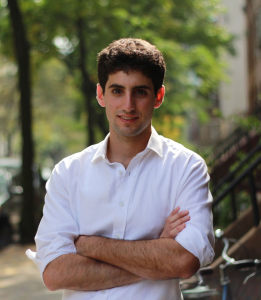
The People’s Climate March took the streets of Manhattan last Sunday, as the city’s largest display of protest against global warming to-date.
Early Sunday morning, at the very front of the People’s Climate March in New York City, a contingent of indigenous peoples made their way to the starting line. They banged drums, shouted chants, and documented, with their cell phones, their own progress forward.
Also documenting their progress forward was a gaggle of press, accompanied by a battery of television and wide-angle-lens cameras bouncing on shoulders and above heads and sweeping along in their advance. “I wanna get the anarchist,” a television reporter said to his cameraman, and they darted toward the middle of the avenue. The anarchist, if that’s what he was, stood silently at the end of the first section of marchers. He was dressed all in black, with a bandanna obscuring his mouth—ready to perform a rearguard action, it seemed. Two feathers and a dream-catcher were tied through the back of his hair. He didn’t say anything to the reporter or cameraman, who stood there for a minute, almost dumbfounded, watching him. In this way, the cameraman missed Senator Chuck Schumer, Democrat of New York, making his way south through a space that had been cleared by police, saying, “Hi nice to see you,” to passersby.
The march wasn’t scheduled to start until 11:30, and organizers were exhorting marchers who were not already in place to continue north along Central Park West or else fill in among the designated subsections: “Front Lines of Crisis/Forefront of Change,” “We Build the Future,” “The Debate Is Over,” all the way down to “To Change Everything, It Takes Everyone.”
At 66th Street, taxis coming through the park dropped off some marchers who studiously took their places; other taxis waited for the light to change, their passengers peering out at the crowds. On the ninth floor of an apartment building on 68th, a man panned his iPad over the scene.
There were the signs, of course: “Another Republican who doesn’t deny climate change,” “Capitalism has no solution for climate change,” “There is no planet b.” In a particularly artistic one, fleshed out with sketches of ships and the shore “I survived superstorm Sandy and all I got was this stupid pipeline: Rockaway.” In the “Food and Water Justice” section: “Divest from Monsanto. Tell your financial adviser to sell their funds that own Monsanto shares.” (On Central Park West, you can’t say they didn’t know their audience.) In the happy mélange of causes, criers, and activists, there were hippies, hipsters, observers, old protest hands, families, college kids. One young man wearing a suit and tie explained that he was combating the negative stereotype of the irresponsible hippie. “I have a job offer,” he said. In the youth section, a group of art students carrying a long painted banner shouted, “Turtle!” whenever they heard helicopters pass overhead and hoisted the banner. The helicopters, in the morning fog, could hardly be seen, only heard.
There was a bottleneck on 72nd Street—people literally packed in from the walls of the park to the western sidewalk’s police lines. Organizers continued urging marchers to move north, to fall in line. On 75th, a frenzied organizer tried to man a gate keeping people along the route path. “We’re gonna let just him through”; “I mean I’m not gonna psychically stop you”; “Well I guess if you have to go to the bathroom you have to go to the bathroom.” Eventually, he gave up. Though noon had come and gone, nobody this far north had yet moved. As one o’clock approached, a people’s mic echo-explained the plan: a moment of silence, and then, right at the stroke of one, everyone would make enough noise for the entire world to hear their rage, concern, and solutions for climate change—particularly directing those shouts across Central Park in the direction of the UN, which would be meeting next week to discuss climate change policy. At 12:58, silence descended. A woman sitting cross-legged amid the bike bloc bowed her head in prayer. An invisible helicopter could be heard far above. The sound, when it erupted, of something like 300,000 people in one long line, echoed in earnest at least.
The march would continue. Eventually, everyone would indeed start moving. Things opened up considerably down at the base of the park, under the watchful eye of Columbus; then bottlenecking again around Times Square (naturally, you might say). Students from Bard College’s MBA in Sustainability would cheer the marchers, hours into their trek, along Sixth Avenue (“It will be a long day,” the March’s website had warned, correctly). For long periods of time, many people stood in one place, chanting one thing.
In the worst of the crush, in the middle of the afternoon, by which point the indigenous peoples and their watchful anarchist leading the way had likely completed their walking task, though those far behind them hadn’t yet stepped a foot: I watched a man push through the mass of humanity and make his way toward the stately stone wall separating the street from Central Park, remark, “Breathing room,” to no one in particular, and vault over into the quiet park itself. There, in some quieter scene of untrammeled nature (or at least Olmstead and Vaux’s acknowledgement of the need to contemplate it), a few marchers had escaped under the trees momentarily. A woman was breastfeeding her child. A man with a guitar was strumming softly. Some people were checking their cell phones, texting, placing calls. Behind the trees the lake gleamed and rowers blissfully rowed. But most lovely of all was watching tired marchers hop over the divide and collapse, joyfully, onto the forgiving dirt.
·
 Mark Chiusano is the author of the book of stories, Marine Park.
Mark Chiusano is the author of the book of stories, Marine Park.
